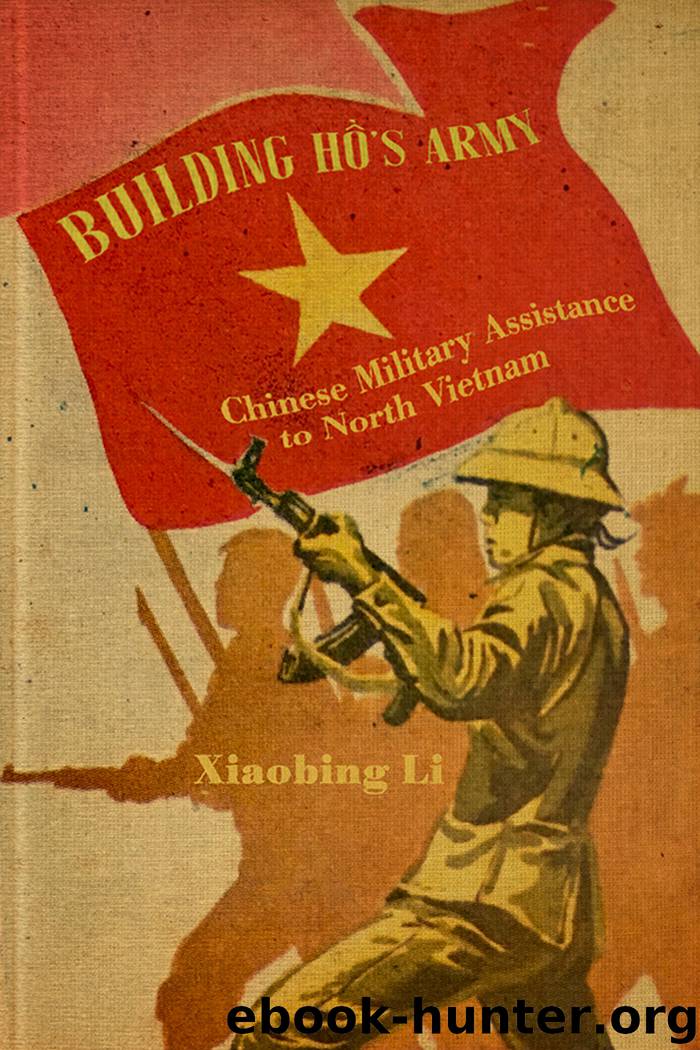Building Ho's Army by Li Xiaobing;

Author:Li, Xiaobing;
Language: eng
Format: epub
Publisher: University Press of Kentucky
Published: 2019-02-26T16:00:00+00:00
CHINESE MISCALCULATION AND PLAN CHANGE
When the Dien Bien Phu Campaign began, the PLA-DGS established a special office, including Generals Zhang Qinghua, Lei Yingfu, Deng Ding, and other staff members, who provided evaluation, communication, and policy suggestions to the PLA high command. They analyzed telegrams, discussed the battle situation, drafted instructions, and organized aid and assistance to the PAVN at Dien Bien Phu on a daily basis from January to May 1954. General Su Yu, chief of the PLA General Staff, met with the office staff and drafted reports to Mao and instructions to the CMAG.56 The PLA Department of General Logistics (DGL) designated Jinping County, Yunnan province, as the supply depot from China to Dien Bien Phu, about ninety miles.57
In January, after the 312th and 304th Infantry Divisions arrived, the main force of four divisions had concentrated at Dien Bien Phu, including eleven regiments and totaling 40,000 troops. The PAVN also concentrated its artillery force by deploying one howitzer regiment, one mountain artillery regiment, four 120mm heavy mortar companies, and three AAA battalions.58
The CMAG’s Military Advisory Group had worked with the PAVN on effective attacks on the fortified defensive positions after their arrival at Dien Bien Phu on December 6.59 Mei Jiasheng proposed two offensive plans. The first approach was to launch massive attacks from multiple directions and use the main force to hit the enemy headquarters at the center to collapse the French defense from the top. Mei described the first method as the “attacking the heart” approach, which would be employed to fight a quick battle for a decisive victory. His second proposal was to attack the French defenses from the outside through piecemeal tactics, one attack at time, in what he called a “skin peeling” approach, with troops fighting steadily, one step at time.60
On January 1, 1954, Giap arrived at Dien Bien Phu as the commander in chief of the Campaign Command, and Hoang Van Thai became the chief of staff. On January 5, Giap visited the front with his staff and the Chinese advisors.61 On January 12, the Front Command had a campaign conference. Hoang Van Thai and many officers agreed with the first Chinese proposal of the quick-victory approach since they worried about food shortages and troop fatigue caused by fighting in the mountains.62 Giap, however, questioned the wisdom of fighting a quick battle. He talked to Wei Guoqing after the conference and explained his disagreement. According to Giap, the PAVN had prepared for a major battle of forty-five days, and there was no reason for the troops to rush to the battle. Wei suggested they hold another campaign conference.63
On January 14, Giap held a campaign planning conference including all the officers at and above the regimental levels. Wei Guoqing, Mei Jiasheng, and other top Chinese military advisors attended as well. Again, his generals and the Chinese advisors agreed on launching attacks soon for a quick victory. Although Giap did not reject the majority’s opinion, his agreement came with a condition that the PAVN would start the attack immediately if nothing had changed.
Download
This site does not store any files on its server. We only index and link to content provided by other sites. Please contact the content providers to delete copyright contents if any and email us, we'll remove relevant links or contents immediately.
| Automotive | Engineering |
| Transportation |
Whiskies Galore by Ian Buxton(41532)
Introduction to Aircraft Design (Cambridge Aerospace Series) by John P. Fielding(32889)
Small Unmanned Fixed-wing Aircraft Design by Andrew J. Keane Andras Sobester James P. Scanlan & András Sóbester & James P. Scanlan(32573)
Craft Beer for the Homebrewer by Michael Agnew(17934)
Turbulence by E. J. Noyes(7701)
The Complete Stick Figure Physics Tutorials by Allen Sarah(7143)
Kaplan MCAT General Chemistry Review by Kaplan(6597)
The Thirst by Nesbo Jo(6439)
Bad Blood by John Carreyrou(6277)
Modelling of Convective Heat and Mass Transfer in Rotating Flows by Igor V. Shevchuk(6224)
Learning SQL by Alan Beaulieu(6036)
Weapons of Math Destruction by Cathy O'Neil(5831)
Man-made Catastrophes and Risk Information Concealment by Dmitry Chernov & Didier Sornette(5649)
Digital Minimalism by Cal Newport;(5390)
Life 3.0: Being Human in the Age of Artificial Intelligence by Tegmark Max(5186)
iGen by Jean M. Twenge(5163)
Secrets of Antigravity Propulsion: Tesla, UFOs, and Classified Aerospace Technology by Ph.D. Paul A. Laviolette(4992)
Design of Trajectory Optimization Approach for Space Maneuver Vehicle Skip Entry Problems by Runqi Chai & Al Savvaris & Antonios Tsourdos & Senchun Chai(4841)
Electronic Devices & Circuits by Jacob Millman & Christos C. Halkias(4748)
